
Introduction
When space is at a premium but your gardening ambitions are sky-high, it’s time to get creative with your resources. As an urban gardener who’s navigated the challenges of tiny balconies and limited yard space, I’ve discovered that wooden pallets are nothing short of miraculous for small-space gardening. These humble wooden structures—often available for free from local businesses—can be transformed into versatile gardening solutions that maximize every inch of your limited space.
The beauty of pallet garden ideas DIY projects lies in their accessibility. You don’t need to be a master carpenter or have an extensive tool collection to create something functional and beautiful. Over the years, I’ve experimented with numerous pallet transformations, sometimes learning the hard way which designs work best for different plants and spaces.
In this article, I’ll share nine innovative ways to repurpose pallets for your small garden space. These projects combine sustainability, affordability, and practicality—perfect for urban dwellers, apartment gardeners, or anyone looking to add more greenery to their life without breaking the bank.
1. Vertical Pallet Planter
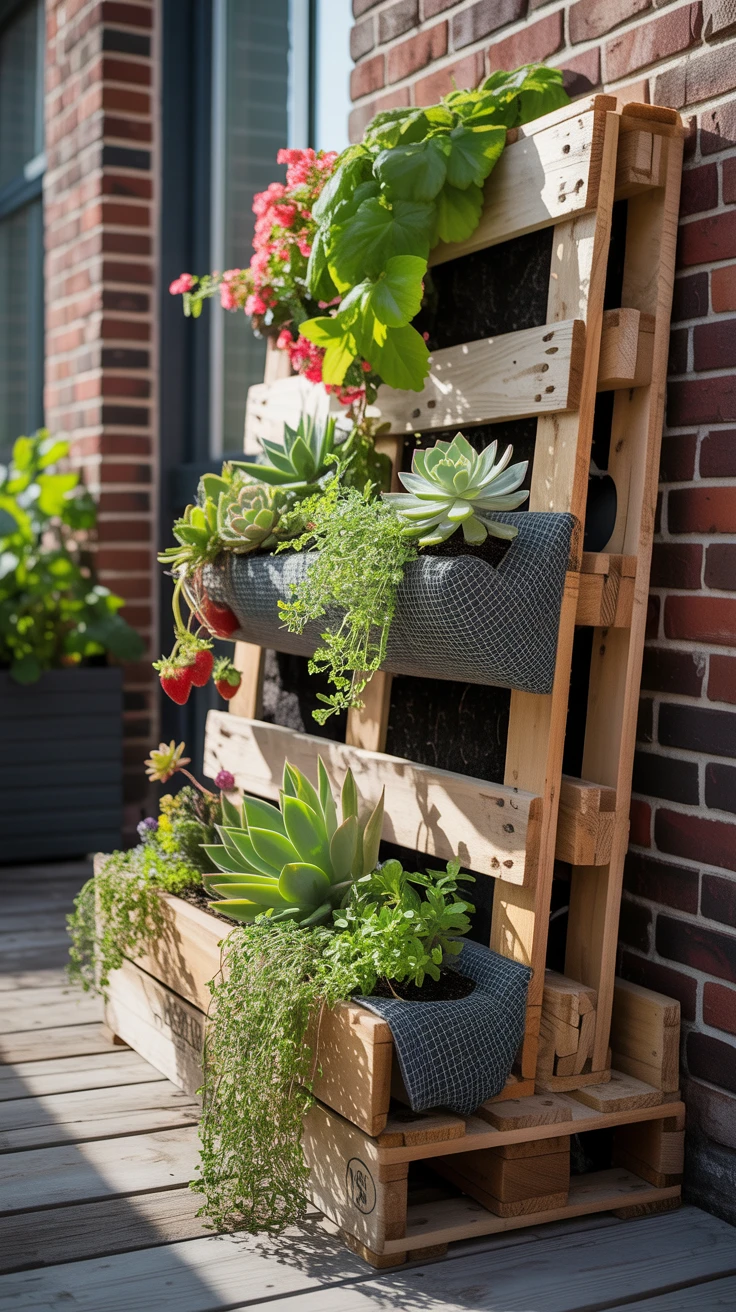
Vertical gardening is a game-changer when horizontal space is limited. I discovered this firsthand when I moved to an apartment with only a narrow balcony. A vertical pallet planter allows you to grow upward rather than outward, utilizing wall space that would otherwise go unused.
To create your own vertical planter, you’ll need a pallet in good condition, landscape fabric, potting soil, and your choice of plants. Succulents, strawberries, herbs, and trailing flowers all work wonderfully in this setup.
- Select a pallet with solid boards and minimal gaps
- Sand down any rough edges to prevent splinters
- Staple landscape fabric to the back, bottom, and sides
- Create pockets between the slats for planting
- Fill with potting soil and add your plants
- Allow the planter to rest horizontally for 1-2 weeks before mounting vertically
Pro Tip: I once made the mistake of hanging my vertical planter immediately after planting. Within days, soil was spilling out and plants were sliding. Always let your vertical pallet garden establish horizontally for at least a week before mounting it to a wall.
2. Pallet Herb Garden
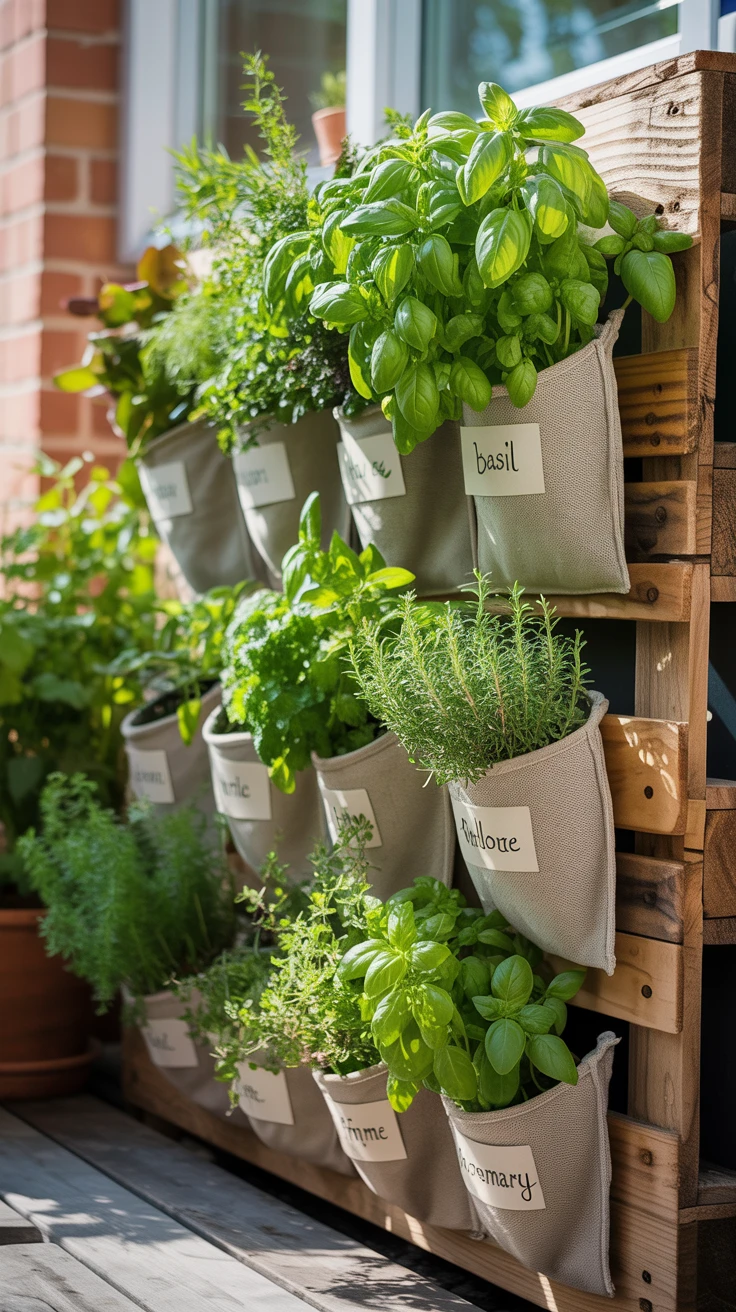
If you’re a cooking enthusiast like me, having fresh herbs at your fingertips is invaluable. A pallet herb garden brings your culinary ingredients within arm’s reach while adding fragrance and beauty to your space.
My first pallet herb garden transformed my cooking experience. I positioned it near my kitchen window, creating easy access to fresh herbs year-round. The vertical design meant I could grow a variety of herbs without sacrificing precious counter or floor space.
For best results, choose herbs that have similar watering and sunlight requirements. Some excellent options include:
- Basil – Perfect for Italian dishes and pesto
- Mint – Great for teas and cocktails
- Parsley – A versatile garnish for many cuisines
- Thyme – Adds depth to soups and stews
- Rosemary – Excellent with roasted meats and potatoes
- Chives – Adds a mild onion flavor to dishes
The structure is similar to the vertical planter but can be modified with smaller planting pockets specifically designed for herbs.
3. Pallet Wall Garden
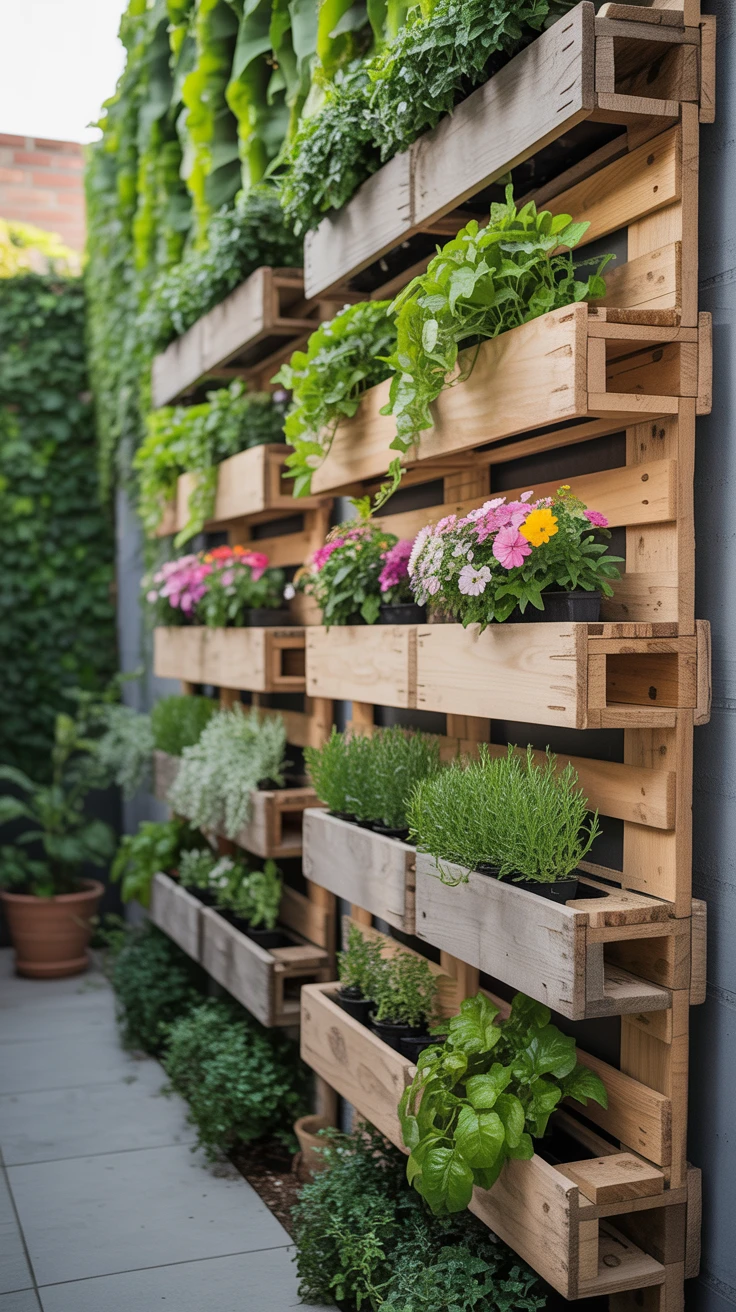
A pallet wall garden takes the vertical planting concept and elevates it to create a living wall of greenery. This approach is perfect for creating privacy, covering unsightly walls, or simply adding a dramatic visual element to your outdoor space.
I installed a pallet wall garden to hide an unattractive concrete wall in my small patio area. Not only did it transform the space aesthetically, but it also created a cooler microclimate during hot summer days.
The key difference between a wall garden and a standard vertical planter is scale and installation. Wall gardens typically use multiple pallets installed side by side to create a larger impact.
Pro Tip: Line the back of your pallet wall garden with heavy-duty landscape fabric or pond liner to prevent water damage to your actual wall. I learned this lesson after noticing some water staining on my exterior wall during the rainy season.
4. Pallet Raised Bed

Raised beds offer numerous advantages for small-space gardeners, from better soil control to improved ergonomics. Creating raised beds from pallets is one of the most straightforward DIY pallet garden ideas and delivers excellent results for growing vegetables and flowers.
To create a basic pallet raised bed:
- Disassemble 2-4 pallets (depending on your desired bed size)
- Construct a rectangular frame using the longer pallet boards
- Attach the remaining boards to create the sides
- Line with landscape fabric if desired
- Fill with quality garden soil and compost
The benefits of raised beds include:
- Improved drainage for healthier plants
- Better soil quality control
- Reduced back strain when gardening
- Clearer boundaries that prevent accidental trampling
- Warmer soil temperatures for earlier planting
5. Pallet Potting Bench
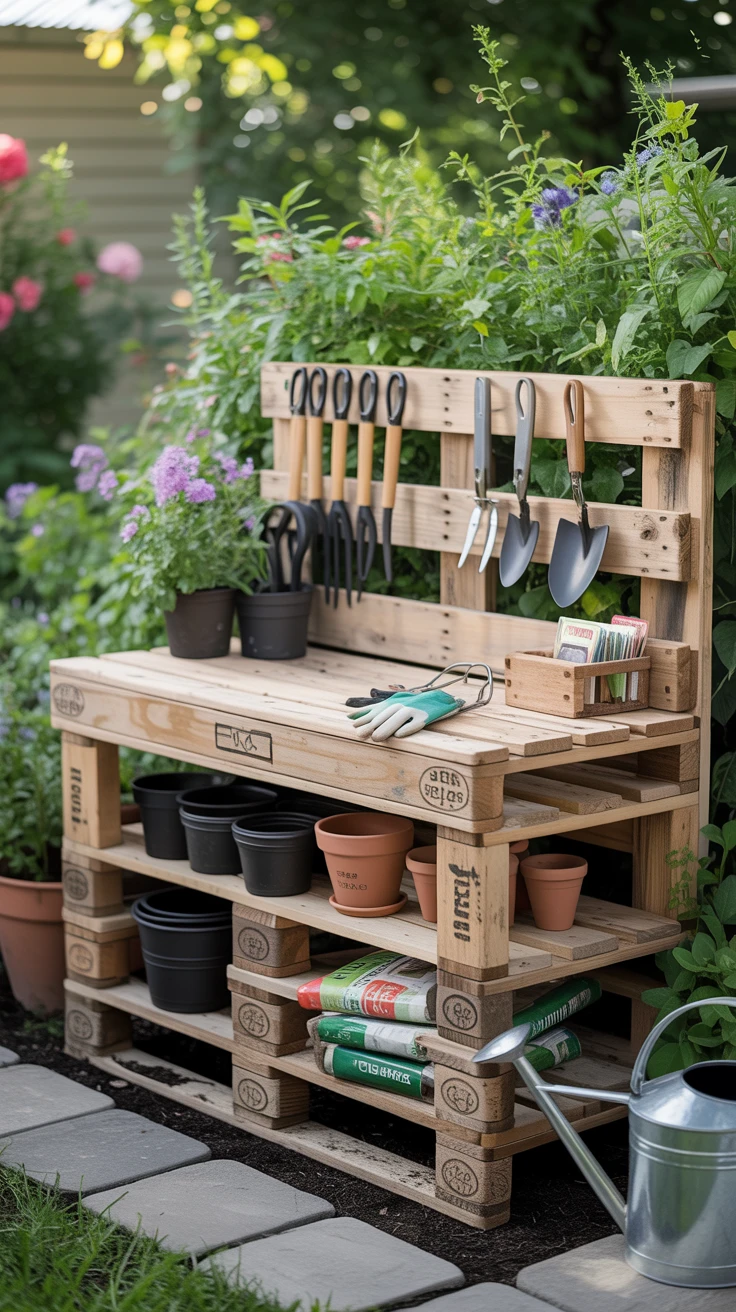
Every gardener needs a dedicated space for potting plants and organizing tools. A pallet potting bench provides this functionality while maintaining the rustic, upcycled aesthetic of your garden space.
When I built my first potting bench from pallets, it revolutionized my gardening workflow. Having a designated area for messy tasks like repotting plants kept soil contained and tools organized.
To create a basic potting bench, you’ll need 3-4 pallets, screws, and basic tools. The design can be as simple or elaborate as you like, potentially including:
- A work surface at comfortable standing height
- Lower shelving for storing pots and soil bags
- Hooks for hanging garden tools
- A small drawer for seed packets and labels
Pro Tip: Apply several coats of exterior-grade varnish or paint to protect your potting bench from moisture and extend its lifespan. I initially skipped this step and had to rebuild portions of my bench after just one season of weather exposure.
6. Pallet Compost Bin

Composting is the cornerstone of sustainable gardening, and a pallet compost bin is perhaps the easiest pallet garden DIY project you can undertake. Creating your own compost reduces waste and provides nutrient-rich soil for your plants.
My pallet compost bin sits in a corner of my small yard, quietly transforming kitchen scraps and garden waste into “black gold” for my plants. It’s been one of the most rewarding garden projects I’ve completed.
To build a simple three-sided compost bin:
- Select three pallets of equal size
- Position them in a U-shape
- Secure the corners together with screws or wire
- Add a fourth pallet as an optional removable front
- Begin adding alternating layers of green and brown materials
Remember to turn your compost regularly and keep it moderately moist for faster decomposition.
7. Pallet Hanging Garden

For those with extremely limited ground space, a pallet hanging garden suspends your plants from above, utilizing vertical space in a different way. This approach is ideal for balconies, fences, or pergolas.
I created a hanging garden on my apartment balcony railing, which allowed me to grow trailing plants like strawberries and ivy without taking up any floor space. The cascading effect created a living curtain that added privacy and beauty.
To create a hanging pallet garden:
- Select a lightweight pallet or cut a standard pallet in half
- Add a solid backing board if the pallet is too open
- Create planting pockets using landscape fabric
- Attach strong hanging hardware to the top
- Plant with lightweight, trailing varieties
Pro Tip: Check your hanging hardware regularly. The weight of plants, soil, and water can strain connections over time. I once had a hanging planter partially collapse because I neglected to inspect the mounting brackets.
8. Pallet Furniture Gardens
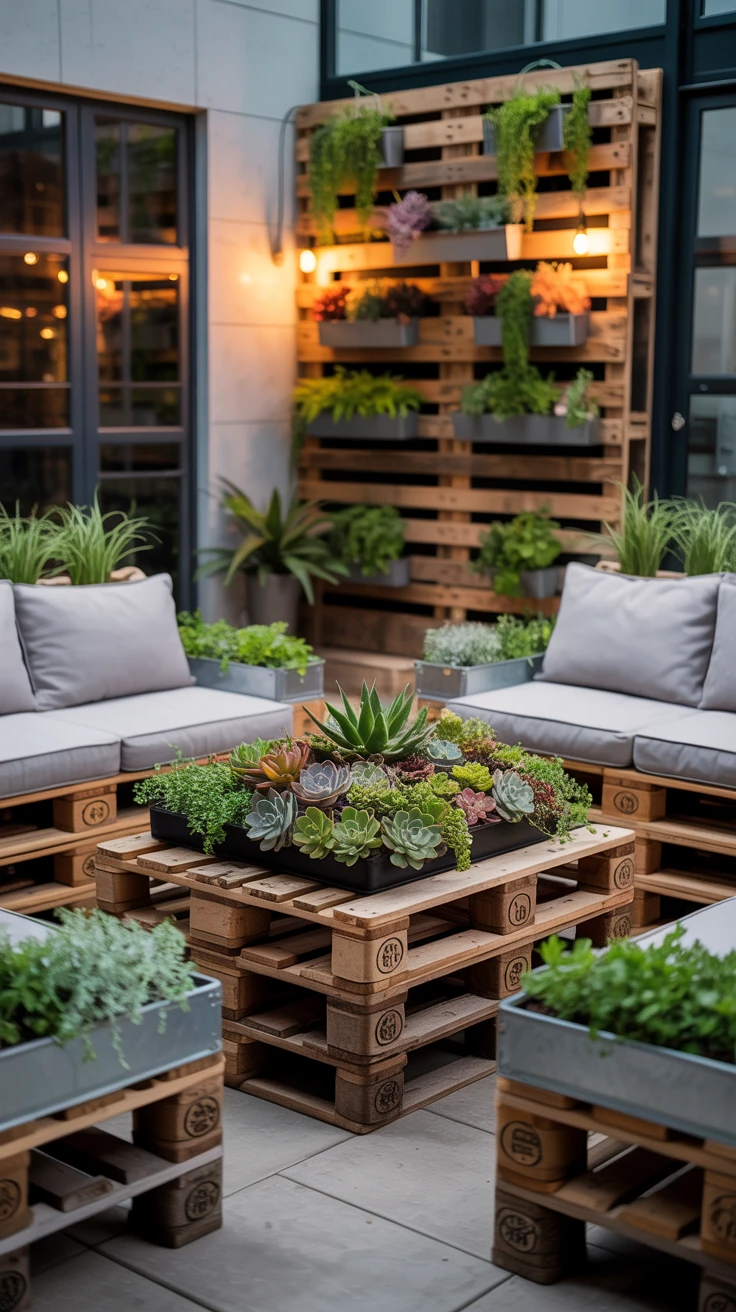
Why separate your seating from your garden when you can combine them? Pallet furniture with integrated planters creates multifunctional pieces perfect for small patios, balconies, or decks.
My favorite piece is a pallet coffee table with a center planting area filled with succulents. It serves as both a practical surface for drinks and a miniature garden that brings nature right to my seating area.
Popular pallet furniture garden ideas include:
- Coffee tables with central planting wells
- Bench seating with planter armrests
- Vertical divider screens with integrated pockets for plants
- Daybed frames with surrounding herb planters
Plants that work well in furniture gardens include succulents, ornamental grasses, and compact herbs that can withstand occasional brushing against them.
9. Pallet Garden Pathway
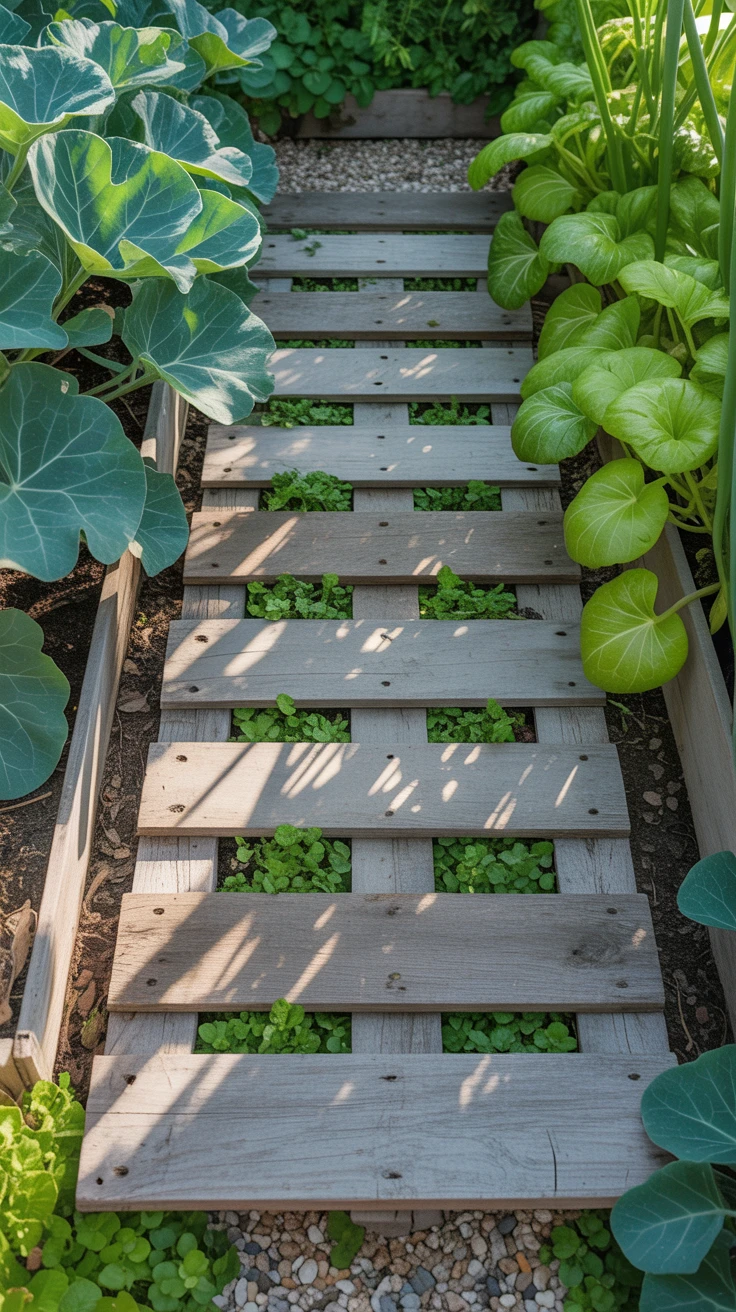
Even in small gardens, pathways help define spaces and protect plants from foot traffic. Pallet wood makes excellent pathway material, adding rustic charm while repurposing materials.
I created a simple pathway through my compact vegetable garden using disassembled pallet boards. The weathered wood blended beautifully with the natural setting and provided clear access to all my plants.
To create a pallet pathway:
- Dismantle pallets into individual boards
- Level and prepare the ground where the path will go
- Arrange boards in your desired pattern (straight, staggered, etc.)
- Secure boards by partially burying them or creating a frame
- Fill gaps with gravel, mulch, or ground cover plants if desired
Pro Tip: Treat your pathway boards with a non-toxic wood preservative to prevent rotting and extend their lifespan. I initially skipped this step and had to replace several boards after just one rainy season.
Conclusion
These nine DIY pallet garden ideas demonstrate just how versatile these humble wooden structures can be for small-space gardening. From vertical planters to multifunctional furniture, pallets offer affordable solutions that maximize growing space while minimizing environmental impact.
I’ve implemented each of these projects in my own small garden spaces over the years, learning valuable lessons along the way. The beauty of working with pallets is that even mistakes become learning opportunities, and projects can be easily modified or rebuilt as your needs change.
Remember to source pallets carefully, looking for the HT (heat-treated) stamp rather than those treated with chemicals. With some creativity, basic tools, and a weekend of work, you can transform your small outdoor space into a thriving garden that reflects your personal style while providing the joy of growing plants in even the most limited spaces.

